The Role of Communication in Assisting Patient Feeding
VerifiedAdded on 2022/08/26
|12
|3734
|19
Essay
AI Summary
This essay delves into the critical aspects of assisting patients with feeding, emphasizing the pivotal role of effective communication in enhancing patient care. It explores the nursing skills required, adherence to the Nursing and Midwifery Code of Conduct (NMC), and the significance of informed consent in ensuring patient autonomy and safety. The essay highlights the importance of understanding patient needs, respecting their preferences, and addressing potential communication barriers arising from diverse backgrounds or language differences. It examines the practical steps involved in assisting patients with feeding, including mealtime preparation, respecting patient pace, and the use of feeding tubes when necessary. Furthermore, it discusses the challenges encountered in informed consent processes and the impact of technology on patient care. The essay underscores the benefits of good communication for both nurses and patients, contributing to improved patient satisfaction, better health outcomes, and a more supportive healthcare environment. Ultimately, the essay advocates for a holistic approach to patient care, where effective communication is central to fostering trust, understanding, and a positive patient experience.
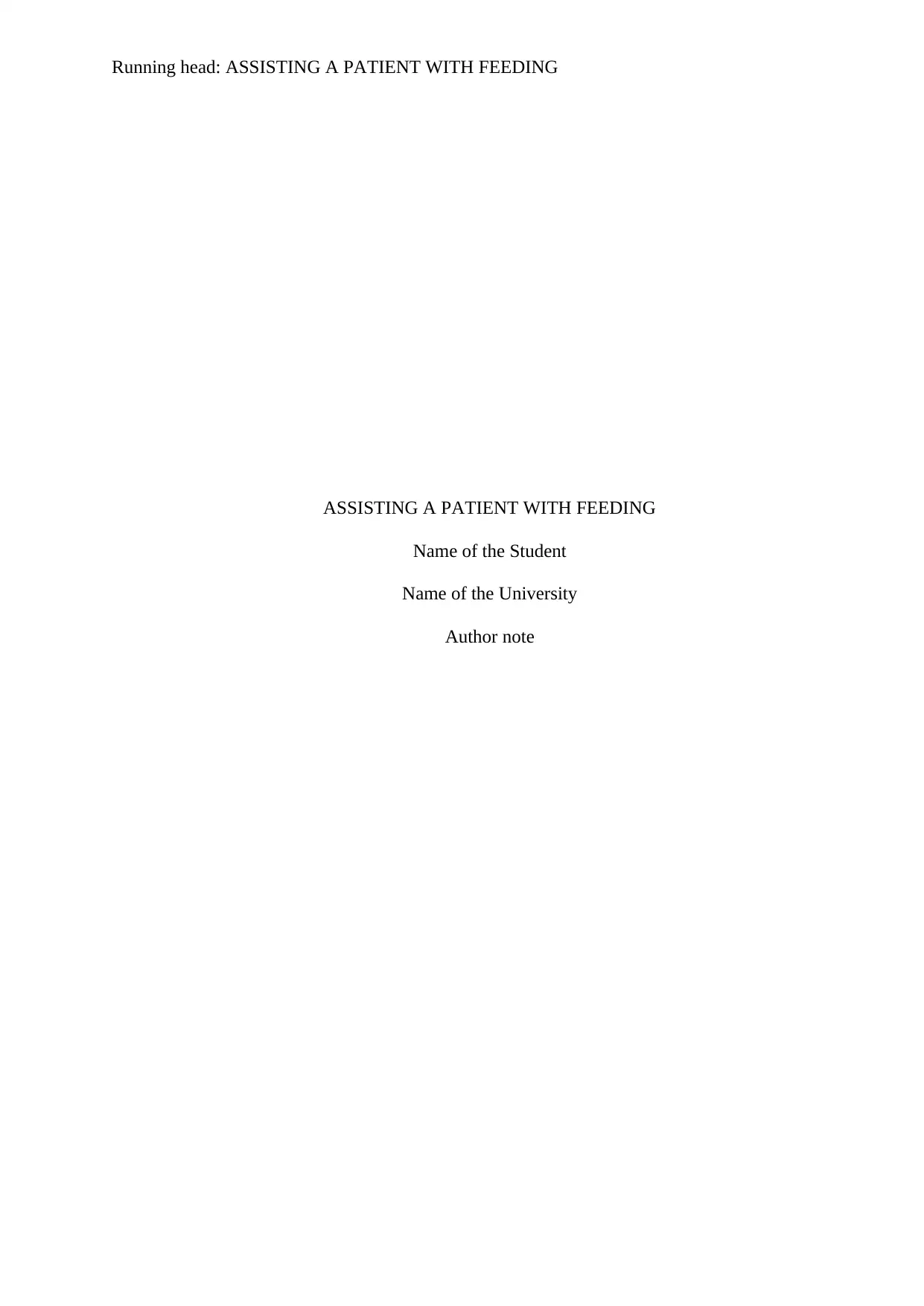
Running head: ASSISTING A PATIENT WITH FEEDING
ASSISTING A PATIENT WITH FEEDING
Name of the Student
Name of the University
Author note
ASSISTING A PATIENT WITH FEEDING
Name of the Student
Name of the University
Author note
Paraphrase This Document
Need a fresh take? Get an instant paraphrase of this document with our AI Paraphraser
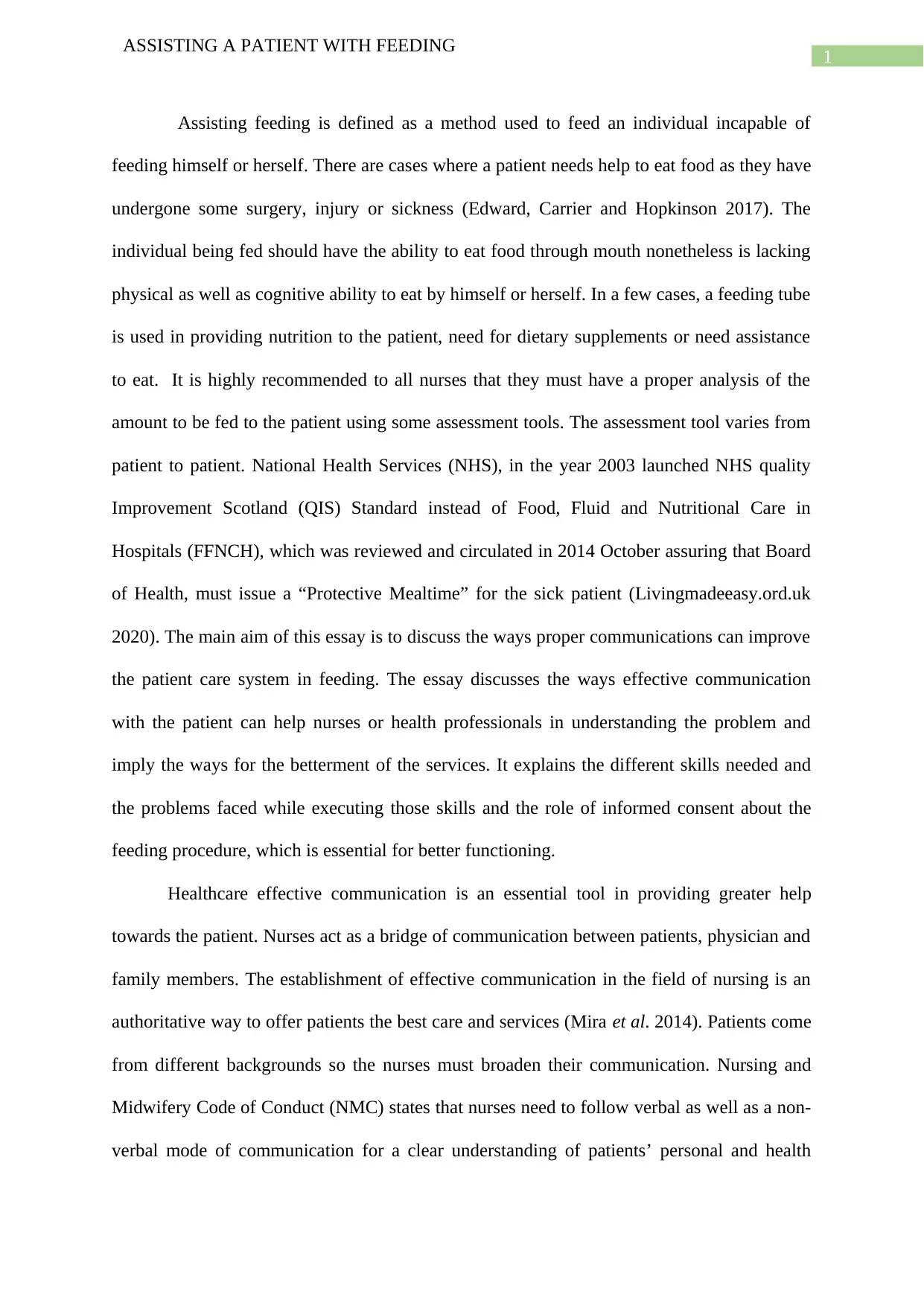
1
ASSISTING A PATIENT WITH FEEDING
Assisting feeding is defined as a method used to feed an individual incapable of
feeding himself or herself. There are cases where a patient needs help to eat food as they have
undergone some surgery, injury or sickness (Edward, Carrier and Hopkinson 2017). The
individual being fed should have the ability to eat food through mouth nonetheless is lacking
physical as well as cognitive ability to eat by himself or herself. In a few cases, a feeding tube
is used in providing nutrition to the patient, need for dietary supplements or need assistance
to eat. It is highly recommended to all nurses that they must have a proper analysis of the
amount to be fed to the patient using some assessment tools. The assessment tool varies from
patient to patient. National Health Services (NHS), in the year 2003 launched NHS quality
Improvement Scotland (QIS) Standard instead of Food, Fluid and Nutritional Care in
Hospitals (FFNCH), which was reviewed and circulated in 2014 October assuring that Board
of Health, must issue a “Protective Mealtime” for the sick patient (Livingmadeeasy.ord.uk
2020). The main aim of this essay is to discuss the ways proper communications can improve
the patient care system in feeding. The essay discusses the ways effective communication
with the patient can help nurses or health professionals in understanding the problem and
imply the ways for the betterment of the services. It explains the different skills needed and
the problems faced while executing those skills and the role of informed consent about the
feeding procedure, which is essential for better functioning.
Healthcare effective communication is an essential tool in providing greater help
towards the patient. Nurses act as a bridge of communication between patients, physician and
family members. The establishment of effective communication in the field of nursing is an
authoritative way to offer patients the best care and services (Mira et al. 2014). Patients come
from different backgrounds so the nurses must broaden their communication. Nursing and
Midwifery Code of Conduct (NMC) states that nurses need to follow verbal as well as a non-
verbal mode of communication for a clear understanding of patients’ personal and health
ASSISTING A PATIENT WITH FEEDING
Assisting feeding is defined as a method used to feed an individual incapable of
feeding himself or herself. There are cases where a patient needs help to eat food as they have
undergone some surgery, injury or sickness (Edward, Carrier and Hopkinson 2017). The
individual being fed should have the ability to eat food through mouth nonetheless is lacking
physical as well as cognitive ability to eat by himself or herself. In a few cases, a feeding tube
is used in providing nutrition to the patient, need for dietary supplements or need assistance
to eat. It is highly recommended to all nurses that they must have a proper analysis of the
amount to be fed to the patient using some assessment tools. The assessment tool varies from
patient to patient. National Health Services (NHS), in the year 2003 launched NHS quality
Improvement Scotland (QIS) Standard instead of Food, Fluid and Nutritional Care in
Hospitals (FFNCH), which was reviewed and circulated in 2014 October assuring that Board
of Health, must issue a “Protective Mealtime” for the sick patient (Livingmadeeasy.ord.uk
2020). The main aim of this essay is to discuss the ways proper communications can improve
the patient care system in feeding. The essay discusses the ways effective communication
with the patient can help nurses or health professionals in understanding the problem and
imply the ways for the betterment of the services. It explains the different skills needed and
the problems faced while executing those skills and the role of informed consent about the
feeding procedure, which is essential for better functioning.
Healthcare effective communication is an essential tool in providing greater help
towards the patient. Nurses act as a bridge of communication between patients, physician and
family members. The establishment of effective communication in the field of nursing is an
authoritative way to offer patients the best care and services (Mira et al. 2014). Patients come
from different backgrounds so the nurses must broaden their communication. Nursing and
Midwifery Code of Conduct (NMC) states that nurses need to follow verbal as well as a non-
verbal mode of communication for a clear understanding of patients’ personal and health
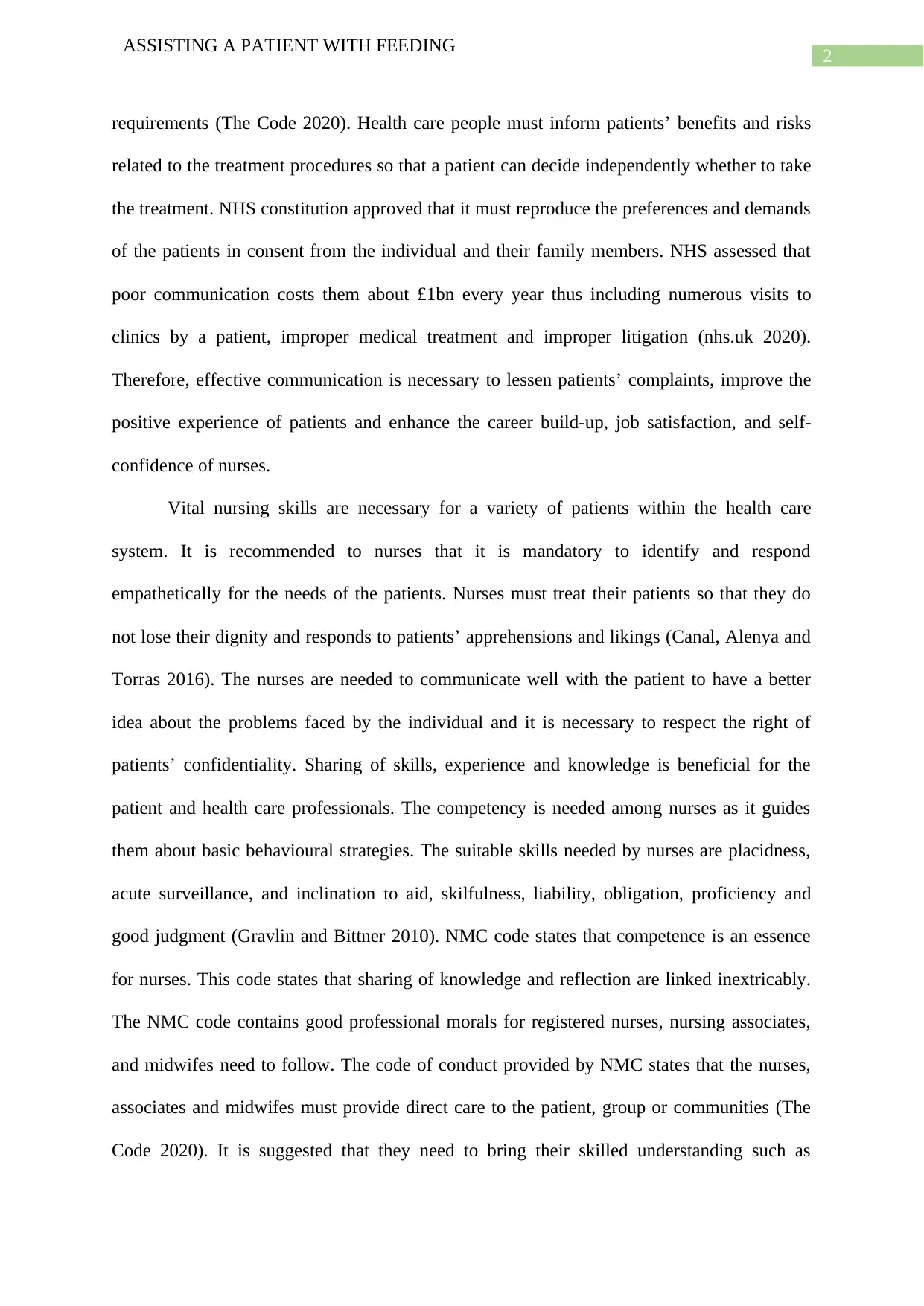
2
ASSISTING A PATIENT WITH FEEDING
requirements (The Code 2020). Health care people must inform patients’ benefits and risks
related to the treatment procedures so that a patient can decide independently whether to take
the treatment. NHS constitution approved that it must reproduce the preferences and demands
of the patients in consent from the individual and their family members. NHS assessed that
poor communication costs them about £1bn every year thus including numerous visits to
clinics by a patient, improper medical treatment and improper litigation (nhs.uk 2020).
Therefore, effective communication is necessary to lessen patients’ complaints, improve the
positive experience of patients and enhance the career build-up, job satisfaction, and self-
confidence of nurses.
Vital nursing skills are necessary for a variety of patients within the health care
system. It is recommended to nurses that it is mandatory to identify and respond
empathetically for the needs of the patients. Nurses must treat their patients so that they do
not lose their dignity and responds to patients’ apprehensions and likings (Canal, Alenya and
Torras 2016). The nurses are needed to communicate well with the patient to have a better
idea about the problems faced by the individual and it is necessary to respect the right of
patients’ confidentiality. Sharing of skills, experience and knowledge is beneficial for the
patient and health care professionals. The competency is needed among nurses as it guides
them about basic behavioural strategies. The suitable skills needed by nurses are placidness,
acute surveillance, and inclination to aid, skilfulness, liability, obligation, proficiency and
good judgment (Gravlin and Bittner 2010). NMC code states that competence is an essence
for nurses. This code states that sharing of knowledge and reflection are linked inextricably.
The NMC code contains good professional morals for registered nurses, nursing associates,
and midwifes need to follow. The code of conduct provided by NMC states that the nurses,
associates and midwifes must provide direct care to the patient, group or communities (The
Code 2020). It is suggested that they need to bring their skilled understanding such as
ASSISTING A PATIENT WITH FEEDING
requirements (The Code 2020). Health care people must inform patients’ benefits and risks
related to the treatment procedures so that a patient can decide independently whether to take
the treatment. NHS constitution approved that it must reproduce the preferences and demands
of the patients in consent from the individual and their family members. NHS assessed that
poor communication costs them about £1bn every year thus including numerous visits to
clinics by a patient, improper medical treatment and improper litigation (nhs.uk 2020).
Therefore, effective communication is necessary to lessen patients’ complaints, improve the
positive experience of patients and enhance the career build-up, job satisfaction, and self-
confidence of nurses.
Vital nursing skills are necessary for a variety of patients within the health care
system. It is recommended to nurses that it is mandatory to identify and respond
empathetically for the needs of the patients. Nurses must treat their patients so that they do
not lose their dignity and responds to patients’ apprehensions and likings (Canal, Alenya and
Torras 2016). The nurses are needed to communicate well with the patient to have a better
idea about the problems faced by the individual and it is necessary to respect the right of
patients’ confidentiality. Sharing of skills, experience and knowledge is beneficial for the
patient and health care professionals. The competency is needed among nurses as it guides
them about basic behavioural strategies. The suitable skills needed by nurses are placidness,
acute surveillance, and inclination to aid, skilfulness, liability, obligation, proficiency and
good judgment (Gravlin and Bittner 2010). NMC code states that competence is an essence
for nurses. This code states that sharing of knowledge and reflection are linked inextricably.
The NMC code contains good professional morals for registered nurses, nursing associates,
and midwifes need to follow. The code of conduct provided by NMC states that the nurses,
associates and midwifes must provide direct care to the patient, group or communities (The
Code 2020). It is suggested that they need to bring their skilled understanding such as
⊘ This is a preview!⊘
Do you want full access?
Subscribe today to unlock all pages.

Trusted by 1+ million students worldwide
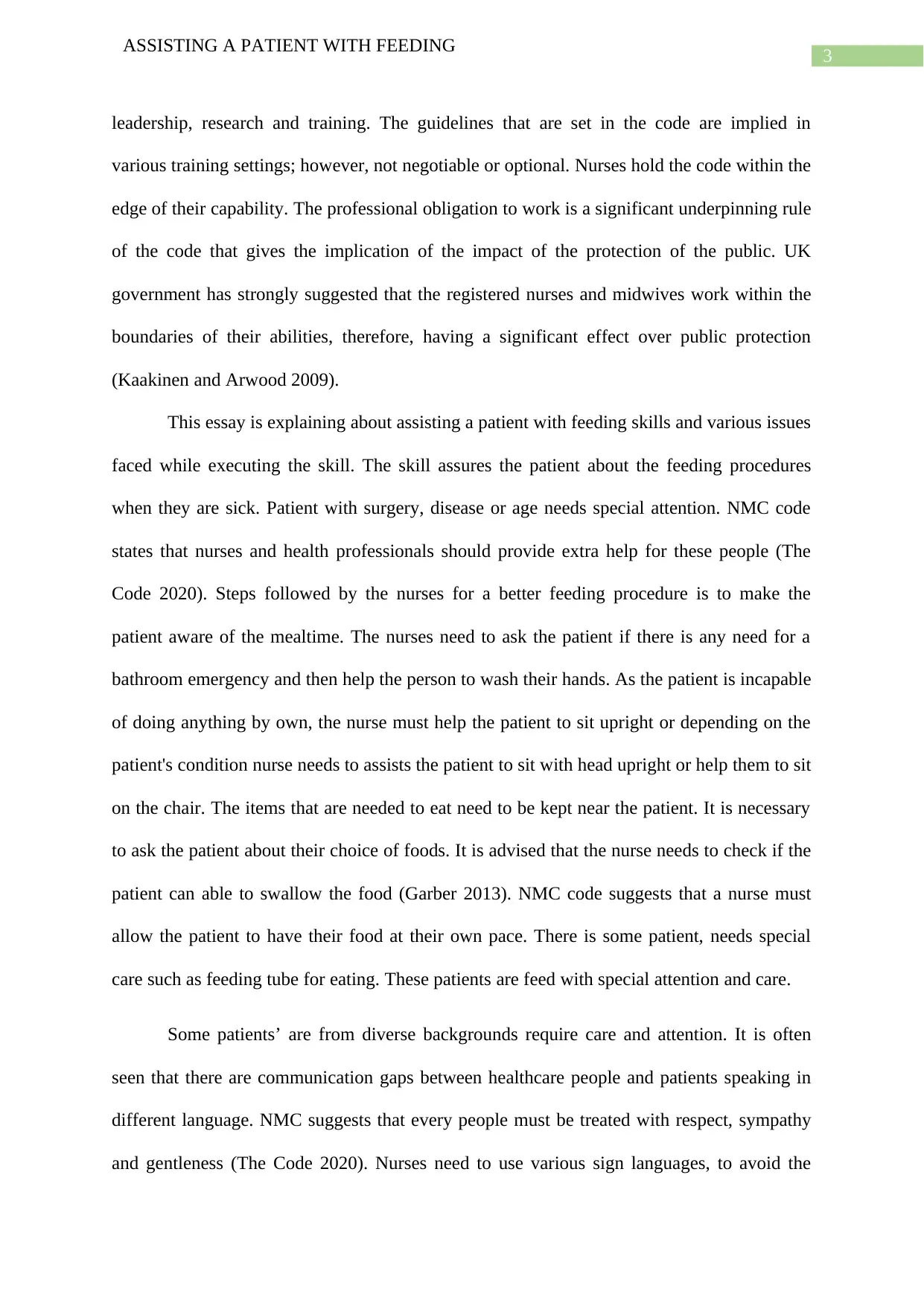
3
ASSISTING A PATIENT WITH FEEDING
leadership, research and training. The guidelines that are set in the code are implied in
various training settings; however, not negotiable or optional. Nurses hold the code within the
edge of their capability. The professional obligation to work is a significant underpinning rule
of the code that gives the implication of the impact of the protection of the public. UK
government has strongly suggested that the registered nurses and midwives work within the
boundaries of their abilities, therefore, having a significant effect over public protection
(Kaakinen and Arwood 2009).
This essay is explaining about assisting a patient with feeding skills and various issues
faced while executing the skill. The skill assures the patient about the feeding procedures
when they are sick. Patient with surgery, disease or age needs special attention. NMC code
states that nurses and health professionals should provide extra help for these people (The
Code 2020). Steps followed by the nurses for a better feeding procedure is to make the
patient aware of the mealtime. The nurses need to ask the patient if there is any need for a
bathroom emergency and then help the person to wash their hands. As the patient is incapable
of doing anything by own, the nurse must help the patient to sit upright or depending on the
patient's condition nurse needs to assists the patient to sit with head upright or help them to sit
on the chair. The items that are needed to eat need to be kept near the patient. It is necessary
to ask the patient about their choice of foods. It is advised that the nurse needs to check if the
patient can able to swallow the food (Garber 2013). NMC code suggests that a nurse must
allow the patient to have their food at their own pace. There is some patient, needs special
care such as feeding tube for eating. These patients are feed with special attention and care.
Some patients’ are from diverse backgrounds require care and attention. It is often
seen that there are communication gaps between healthcare people and patients speaking in
different language. NMC suggests that every people must be treated with respect, sympathy
and gentleness (The Code 2020). Nurses need to use various sign languages, to avoid the
ASSISTING A PATIENT WITH FEEDING
leadership, research and training. The guidelines that are set in the code are implied in
various training settings; however, not negotiable or optional. Nurses hold the code within the
edge of their capability. The professional obligation to work is a significant underpinning rule
of the code that gives the implication of the impact of the protection of the public. UK
government has strongly suggested that the registered nurses and midwives work within the
boundaries of their abilities, therefore, having a significant effect over public protection
(Kaakinen and Arwood 2009).
This essay is explaining about assisting a patient with feeding skills and various issues
faced while executing the skill. The skill assures the patient about the feeding procedures
when they are sick. Patient with surgery, disease or age needs special attention. NMC code
states that nurses and health professionals should provide extra help for these people (The
Code 2020). Steps followed by the nurses for a better feeding procedure is to make the
patient aware of the mealtime. The nurses need to ask the patient if there is any need for a
bathroom emergency and then help the person to wash their hands. As the patient is incapable
of doing anything by own, the nurse must help the patient to sit upright or depending on the
patient's condition nurse needs to assists the patient to sit with head upright or help them to sit
on the chair. The items that are needed to eat need to be kept near the patient. It is necessary
to ask the patient about their choice of foods. It is advised that the nurse needs to check if the
patient can able to swallow the food (Garber 2013). NMC code suggests that a nurse must
allow the patient to have their food at their own pace. There is some patient, needs special
care such as feeding tube for eating. These patients are feed with special attention and care.
Some patients’ are from diverse backgrounds require care and attention. It is often
seen that there are communication gaps between healthcare people and patients speaking in
different language. NMC suggests that every people must be treated with respect, sympathy
and gentleness (The Code 2020). Nurses need to use various sign languages, to avoid the
Paraphrase This Document
Need a fresh take? Get an instant paraphrase of this document with our AI Paraphraser
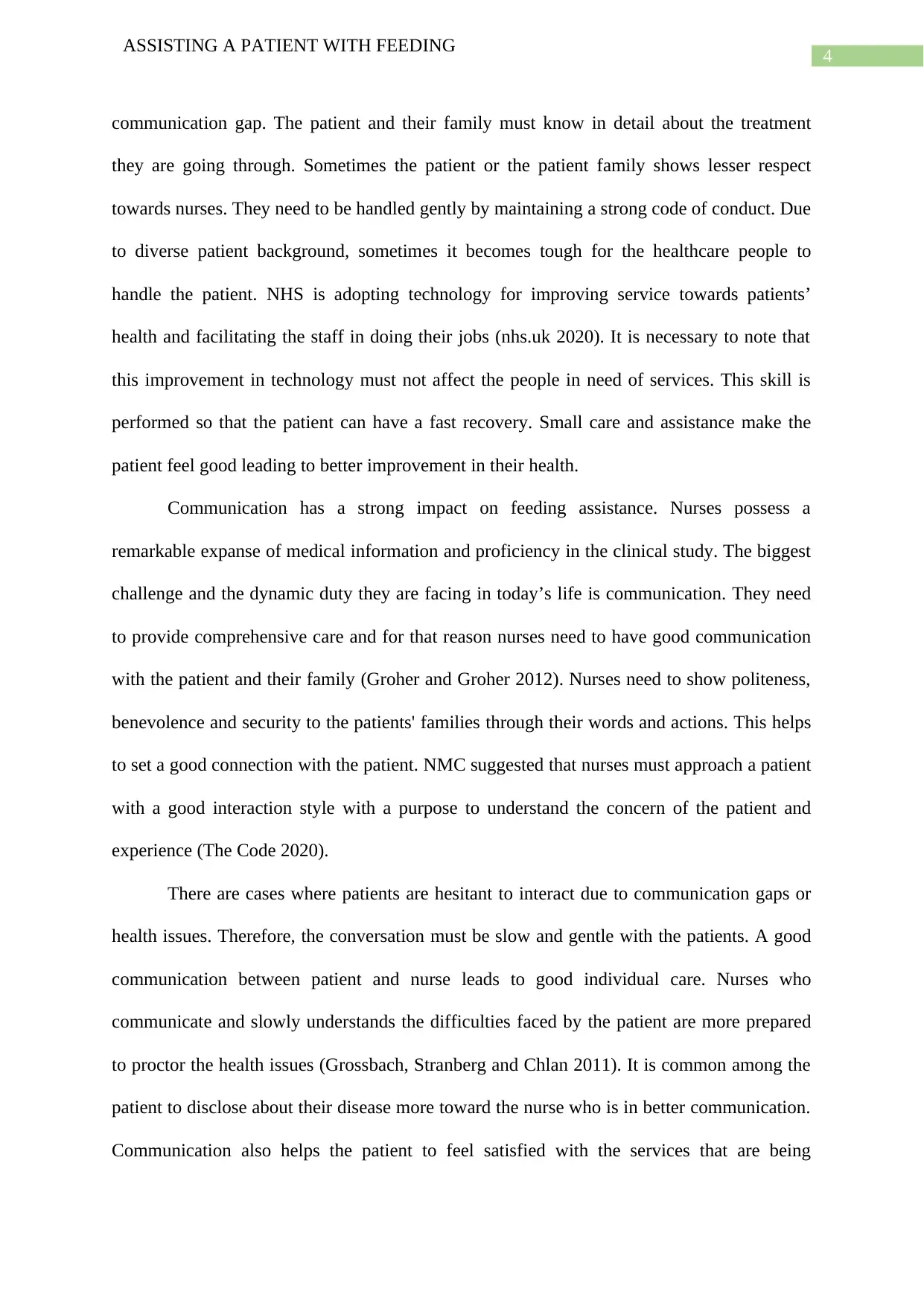
4
ASSISTING A PATIENT WITH FEEDING
communication gap. The patient and their family must know in detail about the treatment
they are going through. Sometimes the patient or the patient family shows lesser respect
towards nurses. They need to be handled gently by maintaining a strong code of conduct. Due
to diverse patient background, sometimes it becomes tough for the healthcare people to
handle the patient. NHS is adopting technology for improving service towards patients’
health and facilitating the staff in doing their jobs (nhs.uk 2020). It is necessary to note that
this improvement in technology must not affect the people in need of services. This skill is
performed so that the patient can have a fast recovery. Small care and assistance make the
patient feel good leading to better improvement in their health.
Communication has a strong impact on feeding assistance. Nurses possess a
remarkable expanse of medical information and proficiency in the clinical study. The biggest
challenge and the dynamic duty they are facing in today’s life is communication. They need
to provide comprehensive care and for that reason nurses need to have good communication
with the patient and their family (Groher and Groher 2012). Nurses need to show politeness,
benevolence and security to the patients' families through their words and actions. This helps
to set a good connection with the patient. NMC suggested that nurses must approach a patient
with a good interaction style with a purpose to understand the concern of the patient and
experience (The Code 2020).
There are cases where patients are hesitant to interact due to communication gaps or
health issues. Therefore, the conversation must be slow and gentle with the patients. A good
communication between patient and nurse leads to good individual care. Nurses who
communicate and slowly understands the difficulties faced by the patient are more prepared
to proctor the health issues (Grossbach, Stranberg and Chlan 2011). It is common among the
patient to disclose about their disease more toward the nurse who is in better communication.
Communication also helps the patient to feel satisfied with the services that are being
ASSISTING A PATIENT WITH FEEDING
communication gap. The patient and their family must know in detail about the treatment
they are going through. Sometimes the patient or the patient family shows lesser respect
towards nurses. They need to be handled gently by maintaining a strong code of conduct. Due
to diverse patient background, sometimes it becomes tough for the healthcare people to
handle the patient. NHS is adopting technology for improving service towards patients’
health and facilitating the staff in doing their jobs (nhs.uk 2020). It is necessary to note that
this improvement in technology must not affect the people in need of services. This skill is
performed so that the patient can have a fast recovery. Small care and assistance make the
patient feel good leading to better improvement in their health.
Communication has a strong impact on feeding assistance. Nurses possess a
remarkable expanse of medical information and proficiency in the clinical study. The biggest
challenge and the dynamic duty they are facing in today’s life is communication. They need
to provide comprehensive care and for that reason nurses need to have good communication
with the patient and their family (Groher and Groher 2012). Nurses need to show politeness,
benevolence and security to the patients' families through their words and actions. This helps
to set a good connection with the patient. NMC suggested that nurses must approach a patient
with a good interaction style with a purpose to understand the concern of the patient and
experience (The Code 2020).
There are cases where patients are hesitant to interact due to communication gaps or
health issues. Therefore, the conversation must be slow and gentle with the patients. A good
communication between patient and nurse leads to good individual care. Nurses who
communicate and slowly understands the difficulties faced by the patient are more prepared
to proctor the health issues (Grossbach, Stranberg and Chlan 2011). It is common among the
patient to disclose about their disease more toward the nurse who is in better communication.
Communication also helps the patient to feel satisfied with the services that are being
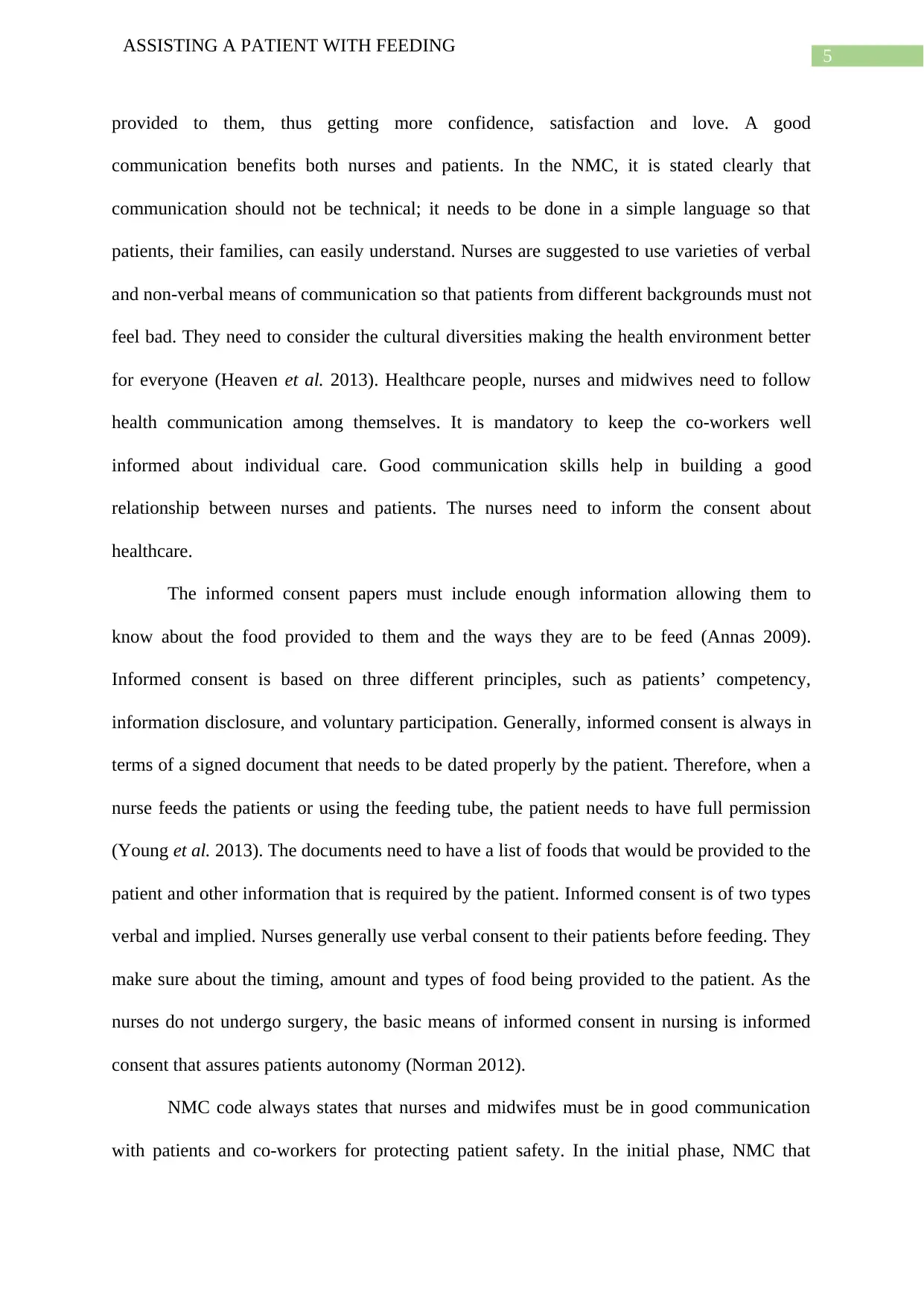
5
ASSISTING A PATIENT WITH FEEDING
provided to them, thus getting more confidence, satisfaction and love. A good
communication benefits both nurses and patients. In the NMC, it is stated clearly that
communication should not be technical; it needs to be done in a simple language so that
patients, their families, can easily understand. Nurses are suggested to use varieties of verbal
and non-verbal means of communication so that patients from different backgrounds must not
feel bad. They need to consider the cultural diversities making the health environment better
for everyone (Heaven et al. 2013). Healthcare people, nurses and midwives need to follow
health communication among themselves. It is mandatory to keep the co-workers well
informed about individual care. Good communication skills help in building a good
relationship between nurses and patients. The nurses need to inform the consent about
healthcare.
The informed consent papers must include enough information allowing them to
know about the food provided to them and the ways they are to be feed (Annas 2009).
Informed consent is based on three different principles, such as patients’ competency,
information disclosure, and voluntary participation. Generally, informed consent is always in
terms of a signed document that needs to be dated properly by the patient. Therefore, when a
nurse feeds the patients or using the feeding tube, the patient needs to have full permission
(Young et al. 2013). The documents need to have a list of foods that would be provided to the
patient and other information that is required by the patient. Informed consent is of two types
verbal and implied. Nurses generally use verbal consent to their patients before feeding. They
make sure about the timing, amount and types of food being provided to the patient. As the
nurses do not undergo surgery, the basic means of informed consent in nursing is informed
consent that assures patients autonomy (Norman 2012).
NMC code always states that nurses and midwifes must be in good communication
with patients and co-workers for protecting patient safety. In the initial phase, NMC that
ASSISTING A PATIENT WITH FEEDING
provided to them, thus getting more confidence, satisfaction and love. A good
communication benefits both nurses and patients. In the NMC, it is stated clearly that
communication should not be technical; it needs to be done in a simple language so that
patients, their families, can easily understand. Nurses are suggested to use varieties of verbal
and non-verbal means of communication so that patients from different backgrounds must not
feel bad. They need to consider the cultural diversities making the health environment better
for everyone (Heaven et al. 2013). Healthcare people, nurses and midwives need to follow
health communication among themselves. It is mandatory to keep the co-workers well
informed about individual care. Good communication skills help in building a good
relationship between nurses and patients. The nurses need to inform the consent about
healthcare.
The informed consent papers must include enough information allowing them to
know about the food provided to them and the ways they are to be feed (Annas 2009).
Informed consent is based on three different principles, such as patients’ competency,
information disclosure, and voluntary participation. Generally, informed consent is always in
terms of a signed document that needs to be dated properly by the patient. Therefore, when a
nurse feeds the patients or using the feeding tube, the patient needs to have full permission
(Young et al. 2013). The documents need to have a list of foods that would be provided to the
patient and other information that is required by the patient. Informed consent is of two types
verbal and implied. Nurses generally use verbal consent to their patients before feeding. They
make sure about the timing, amount and types of food being provided to the patient. As the
nurses do not undergo surgery, the basic means of informed consent in nursing is informed
consent that assures patients autonomy (Norman 2012).
NMC code always states that nurses and midwifes must be in good communication
with patients and co-workers for protecting patient safety. In the initial phase, NMC that
⊘ This is a preview!⊘
Do you want full access?
Subscribe today to unlock all pages.

Trusted by 1+ million students worldwide
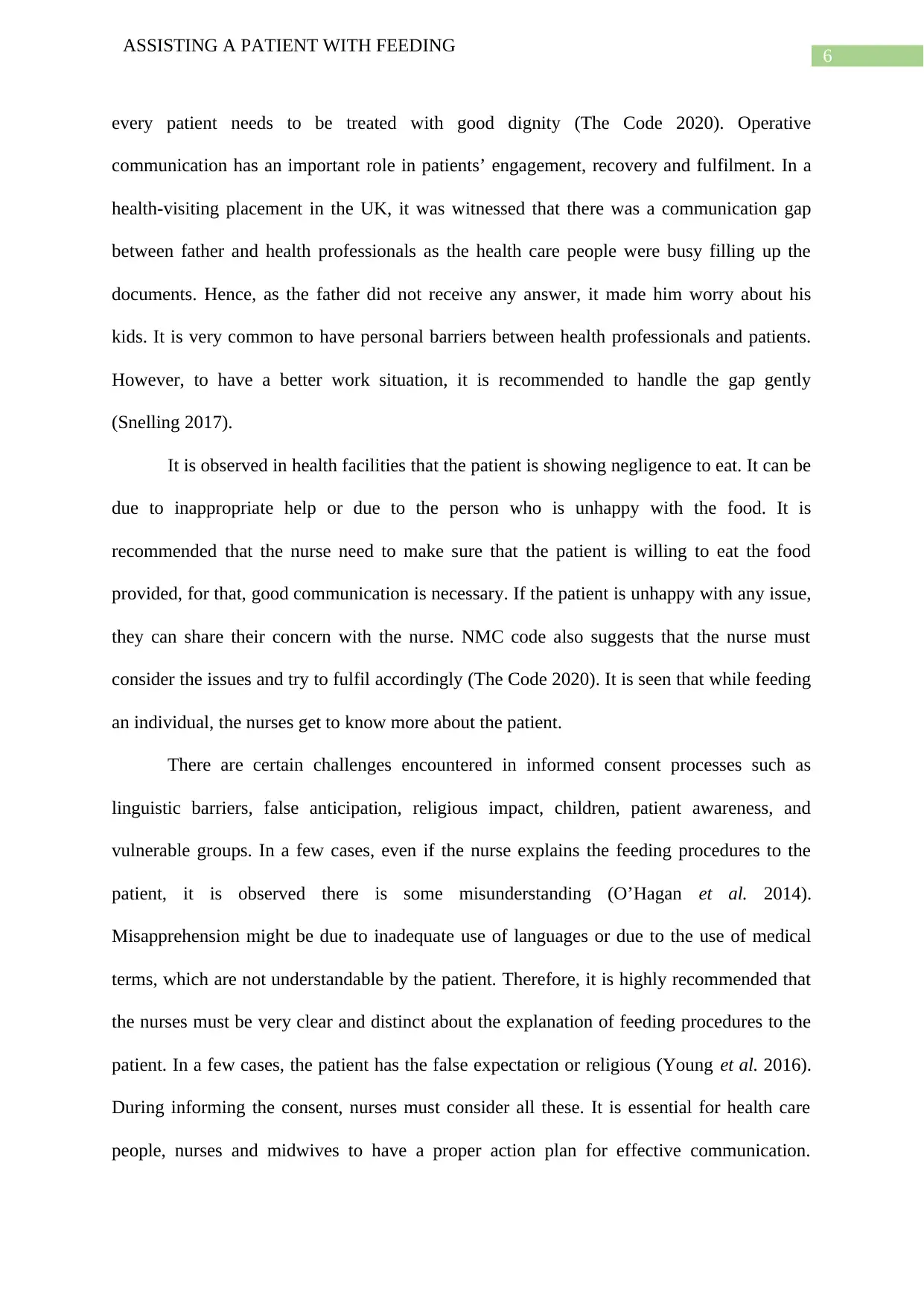
6
ASSISTING A PATIENT WITH FEEDING
every patient needs to be treated with good dignity (The Code 2020). Operative
communication has an important role in patients’ engagement, recovery and fulfilment. In a
health-visiting placement in the UK, it was witnessed that there was a communication gap
between father and health professionals as the health care people were busy filling up the
documents. Hence, as the father did not receive any answer, it made him worry about his
kids. It is very common to have personal barriers between health professionals and patients.
However, to have a better work situation, it is recommended to handle the gap gently
(Snelling 2017).
It is observed in health facilities that the patient is showing negligence to eat. It can be
due to inappropriate help or due to the person who is unhappy with the food. It is
recommended that the nurse need to make sure that the patient is willing to eat the food
provided, for that, good communication is necessary. If the patient is unhappy with any issue,
they can share their concern with the nurse. NMC code also suggests that the nurse must
consider the issues and try to fulfil accordingly (The Code 2020). It is seen that while feeding
an individual, the nurses get to know more about the patient.
There are certain challenges encountered in informed consent processes such as
linguistic barriers, false anticipation, religious impact, children, patient awareness, and
vulnerable groups. In a few cases, even if the nurse explains the feeding procedures to the
patient, it is observed there is some misunderstanding (O’Hagan et al. 2014).
Misapprehension might be due to inadequate use of languages or due to the use of medical
terms, which are not understandable by the patient. Therefore, it is highly recommended that
the nurses must be very clear and distinct about the explanation of feeding procedures to the
patient. In a few cases, the patient has the false expectation or religious (Young et al. 2016).
During informing the consent, nurses must consider all these. It is essential for health care
people, nurses and midwives to have a proper action plan for effective communication.
ASSISTING A PATIENT WITH FEEDING
every patient needs to be treated with good dignity (The Code 2020). Operative
communication has an important role in patients’ engagement, recovery and fulfilment. In a
health-visiting placement in the UK, it was witnessed that there was a communication gap
between father and health professionals as the health care people were busy filling up the
documents. Hence, as the father did not receive any answer, it made him worry about his
kids. It is very common to have personal barriers between health professionals and patients.
However, to have a better work situation, it is recommended to handle the gap gently
(Snelling 2017).
It is observed in health facilities that the patient is showing negligence to eat. It can be
due to inappropriate help or due to the person who is unhappy with the food. It is
recommended that the nurse need to make sure that the patient is willing to eat the food
provided, for that, good communication is necessary. If the patient is unhappy with any issue,
they can share their concern with the nurse. NMC code also suggests that the nurse must
consider the issues and try to fulfil accordingly (The Code 2020). It is seen that while feeding
an individual, the nurses get to know more about the patient.
There are certain challenges encountered in informed consent processes such as
linguistic barriers, false anticipation, religious impact, children, patient awareness, and
vulnerable groups. In a few cases, even if the nurse explains the feeding procedures to the
patient, it is observed there is some misunderstanding (O’Hagan et al. 2014).
Misapprehension might be due to inadequate use of languages or due to the use of medical
terms, which are not understandable by the patient. Therefore, it is highly recommended that
the nurses must be very clear and distinct about the explanation of feeding procedures to the
patient. In a few cases, the patient has the false expectation or religious (Young et al. 2016).
During informing the consent, nurses must consider all these. It is essential for health care
people, nurses and midwives to have a proper action plan for effective communication.
Paraphrase This Document
Need a fresh take? Get an instant paraphrase of this document with our AI Paraphraser
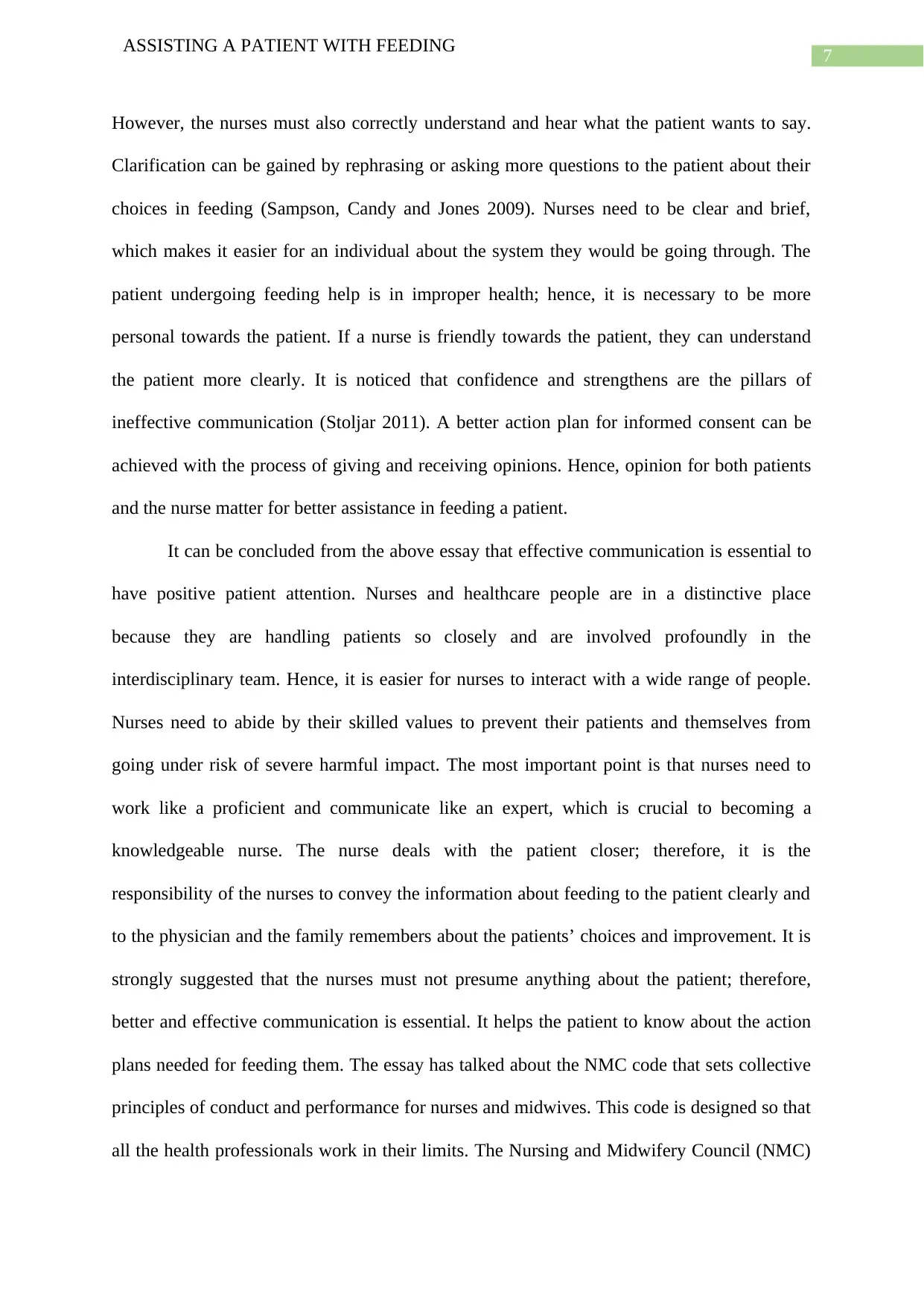
7
ASSISTING A PATIENT WITH FEEDING
However, the nurses must also correctly understand and hear what the patient wants to say.
Clarification can be gained by rephrasing or asking more questions to the patient about their
choices in feeding (Sampson, Candy and Jones 2009). Nurses need to be clear and brief,
which makes it easier for an individual about the system they would be going through. The
patient undergoing feeding help is in improper health; hence, it is necessary to be more
personal towards the patient. If a nurse is friendly towards the patient, they can understand
the patient more clearly. It is noticed that confidence and strengthens are the pillars of
ineffective communication (Stoljar 2011). A better action plan for informed consent can be
achieved with the process of giving and receiving opinions. Hence, opinion for both patients
and the nurse matter for better assistance in feeding a patient.
It can be concluded from the above essay that effective communication is essential to
have positive patient attention. Nurses and healthcare people are in a distinctive place
because they are handling patients so closely and are involved profoundly in the
interdisciplinary team. Hence, it is easier for nurses to interact with a wide range of people.
Nurses need to abide by their skilled values to prevent their patients and themselves from
going under risk of severe harmful impact. The most important point is that nurses need to
work like a proficient and communicate like an expert, which is crucial to becoming a
knowledgeable nurse. The nurse deals with the patient closer; therefore, it is the
responsibility of the nurses to convey the information about feeding to the patient clearly and
to the physician and the family remembers about the patients’ choices and improvement. It is
strongly suggested that the nurses must not presume anything about the patient; therefore,
better and effective communication is essential. It helps the patient to know about the action
plans needed for feeding them. The essay has talked about the NMC code that sets collective
principles of conduct and performance for nurses and midwives. This code is designed so that
all the health professionals work in their limits. The Nursing and Midwifery Council (NMC)
ASSISTING A PATIENT WITH FEEDING
However, the nurses must also correctly understand and hear what the patient wants to say.
Clarification can be gained by rephrasing or asking more questions to the patient about their
choices in feeding (Sampson, Candy and Jones 2009). Nurses need to be clear and brief,
which makes it easier for an individual about the system they would be going through. The
patient undergoing feeding help is in improper health; hence, it is necessary to be more
personal towards the patient. If a nurse is friendly towards the patient, they can understand
the patient more clearly. It is noticed that confidence and strengthens are the pillars of
ineffective communication (Stoljar 2011). A better action plan for informed consent can be
achieved with the process of giving and receiving opinions. Hence, opinion for both patients
and the nurse matter for better assistance in feeding a patient.
It can be concluded from the above essay that effective communication is essential to
have positive patient attention. Nurses and healthcare people are in a distinctive place
because they are handling patients so closely and are involved profoundly in the
interdisciplinary team. Hence, it is easier for nurses to interact with a wide range of people.
Nurses need to abide by their skilled values to prevent their patients and themselves from
going under risk of severe harmful impact. The most important point is that nurses need to
work like a proficient and communicate like an expert, which is crucial to becoming a
knowledgeable nurse. The nurse deals with the patient closer; therefore, it is the
responsibility of the nurses to convey the information about feeding to the patient clearly and
to the physician and the family remembers about the patients’ choices and improvement. It is
strongly suggested that the nurses must not presume anything about the patient; therefore,
better and effective communication is essential. It helps the patient to know about the action
plans needed for feeding them. The essay has talked about the NMC code that sets collective
principles of conduct and performance for nurses and midwives. This code is designed so that
all the health professionals work in their limits. The Nursing and Midwifery Council (NMC)
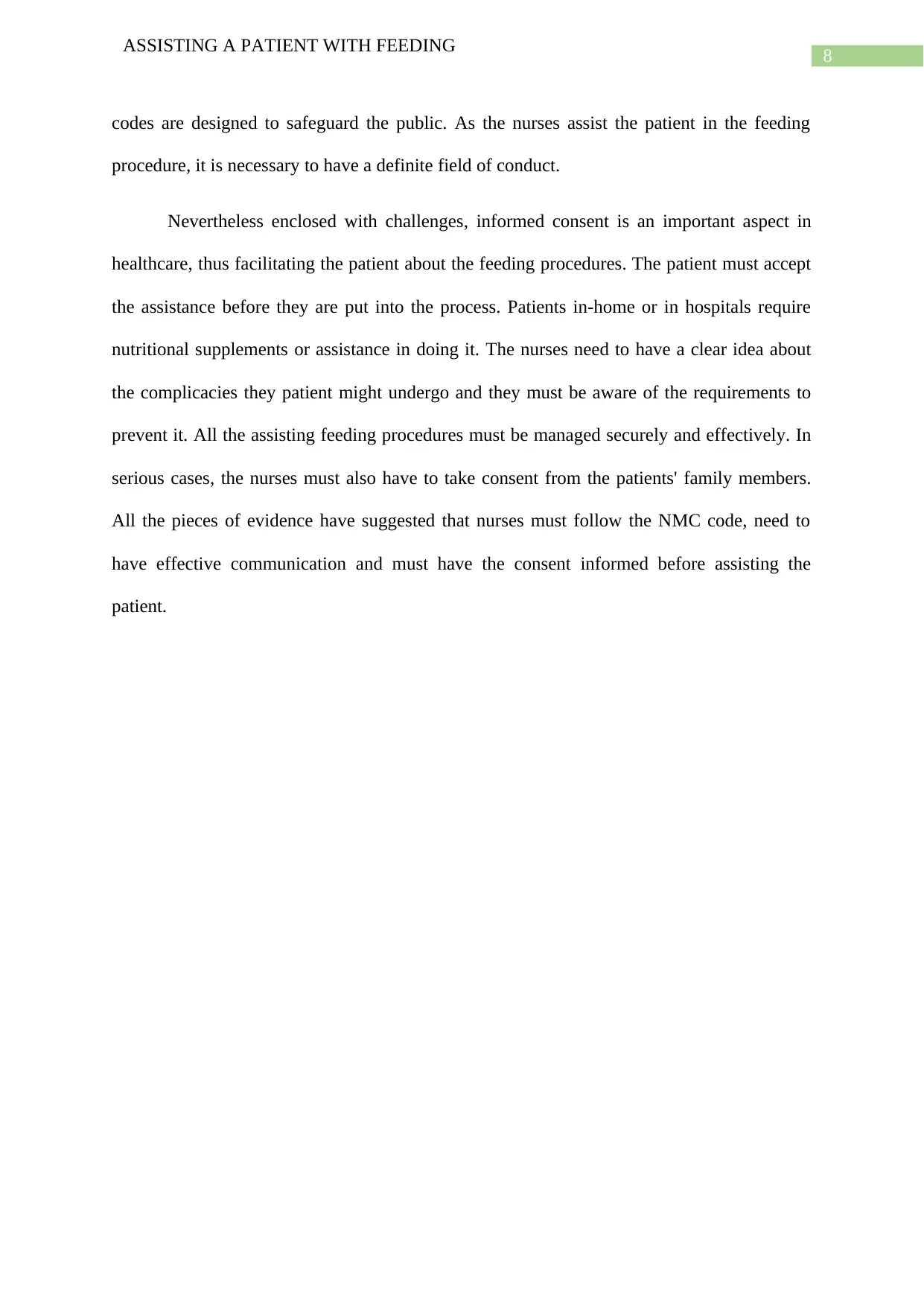
8
ASSISTING A PATIENT WITH FEEDING
codes are designed to safeguard the public. As the nurses assist the patient in the feeding
procedure, it is necessary to have a definite field of conduct.
Nevertheless enclosed with challenges, informed consent is an important aspect in
healthcare, thus facilitating the patient about the feeding procedures. The patient must accept
the assistance before they are put into the process. Patients in-home or in hospitals require
nutritional supplements or assistance in doing it. The nurses need to have a clear idea about
the complicacies they patient might undergo and they must be aware of the requirements to
prevent it. All the assisting feeding procedures must be managed securely and effectively. In
serious cases, the nurses must also have to take consent from the patients' family members.
All the pieces of evidence have suggested that nurses must follow the NMC code, need to
have effective communication and must have the consent informed before assisting the
patient.
ASSISTING A PATIENT WITH FEEDING
codes are designed to safeguard the public. As the nurses assist the patient in the feeding
procedure, it is necessary to have a definite field of conduct.
Nevertheless enclosed with challenges, informed consent is an important aspect in
healthcare, thus facilitating the patient about the feeding procedures. The patient must accept
the assistance before they are put into the process. Patients in-home or in hospitals require
nutritional supplements or assistance in doing it. The nurses need to have a clear idea about
the complicacies they patient might undergo and they must be aware of the requirements to
prevent it. All the assisting feeding procedures must be managed securely and effectively. In
serious cases, the nurses must also have to take consent from the patients' family members.
All the pieces of evidence have suggested that nurses must follow the NMC code, need to
have effective communication and must have the consent informed before assisting the
patient.
⊘ This is a preview!⊘
Do you want full access?
Subscribe today to unlock all pages.

Trusted by 1+ million students worldwide
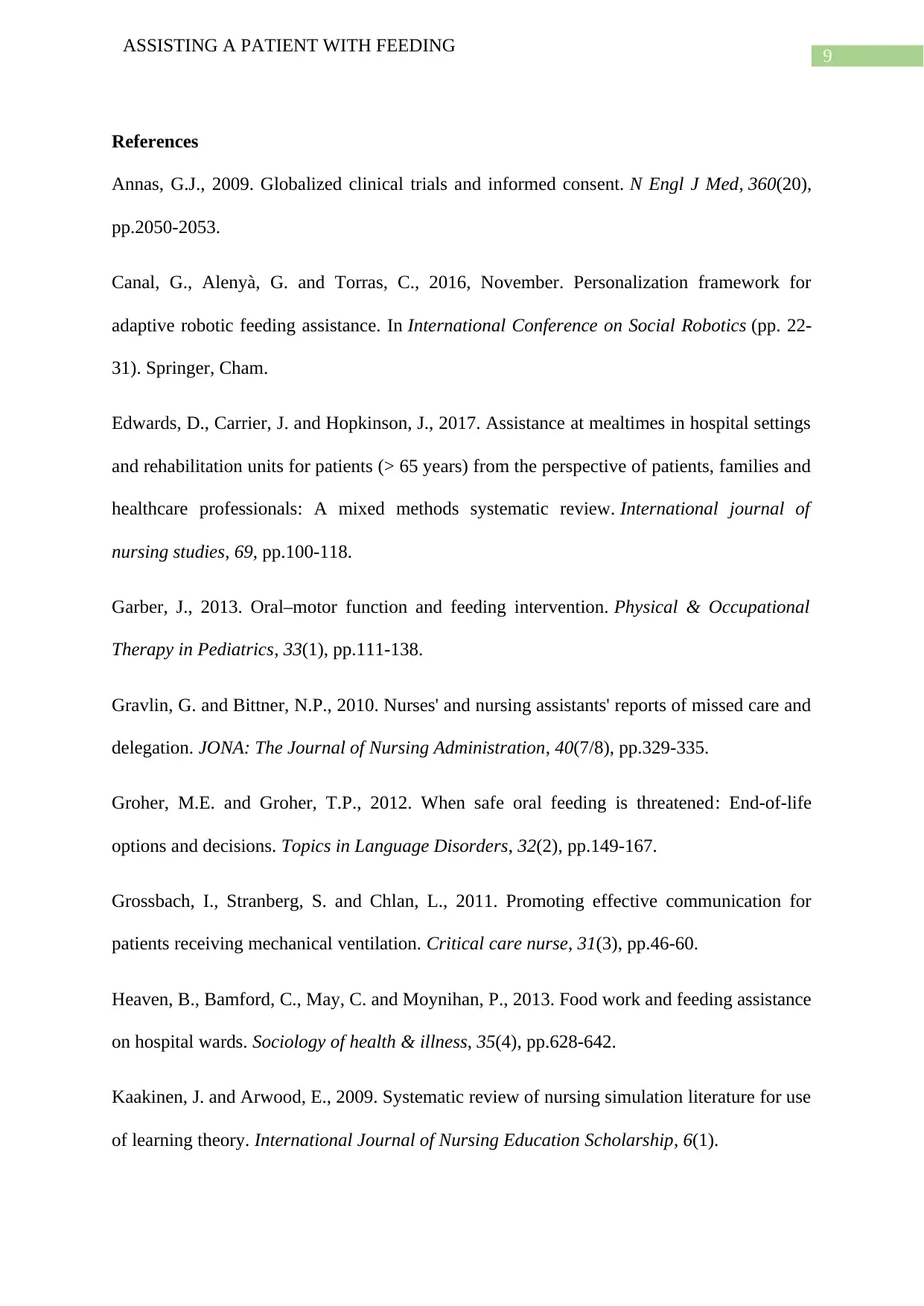
9
ASSISTING A PATIENT WITH FEEDING
References
Annas, G.J., 2009. Globalized clinical trials and informed consent. N Engl J Med, 360(20),
pp.2050-2053.
Canal, G., Alenyà, G. and Torras, C., 2016, November. Personalization framework for
adaptive robotic feeding assistance. In International Conference on Social Robotics (pp. 22-
31). Springer, Cham.
Edwards, D., Carrier, J. and Hopkinson, J., 2017. Assistance at mealtimes in hospital settings
and rehabilitation units for patients (> 65 years) from the perspective of patients, families and
healthcare professionals: A mixed methods systematic review. International journal of
nursing studies, 69, pp.100-118.
Garber, J., 2013. Oral–motor function and feeding intervention. Physical & Occupational
Therapy in Pediatrics, 33(1), pp.111-138.
Gravlin, G. and Bittner, N.P., 2010. Nurses' and nursing assistants' reports of missed care and
delegation. JONA: The Journal of Nursing Administration, 40(7/8), pp.329-335.
Groher, M.E. and Groher, T.P., 2012. When safe oral feeding is threatened: End-of-life
options and decisions. Topics in Language Disorders, 32(2), pp.149-167.
Grossbach, I., Stranberg, S. and Chlan, L., 2011. Promoting effective communication for
patients receiving mechanical ventilation. Critical care nurse, 31(3), pp.46-60.
Heaven, B., Bamford, C., May, C. and Moynihan, P., 2013. Food work and feeding assistance
on hospital wards. Sociology of health & illness, 35(4), pp.628-642.
Kaakinen, J. and Arwood, E., 2009. Systematic review of nursing simulation literature for use
of learning theory. International Journal of Nursing Education Scholarship, 6(1).
ASSISTING A PATIENT WITH FEEDING
References
Annas, G.J., 2009. Globalized clinical trials and informed consent. N Engl J Med, 360(20),
pp.2050-2053.
Canal, G., Alenyà, G. and Torras, C., 2016, November. Personalization framework for
adaptive robotic feeding assistance. In International Conference on Social Robotics (pp. 22-
31). Springer, Cham.
Edwards, D., Carrier, J. and Hopkinson, J., 2017. Assistance at mealtimes in hospital settings
and rehabilitation units for patients (> 65 years) from the perspective of patients, families and
healthcare professionals: A mixed methods systematic review. International journal of
nursing studies, 69, pp.100-118.
Garber, J., 2013. Oral–motor function and feeding intervention. Physical & Occupational
Therapy in Pediatrics, 33(1), pp.111-138.
Gravlin, G. and Bittner, N.P., 2010. Nurses' and nursing assistants' reports of missed care and
delegation. JONA: The Journal of Nursing Administration, 40(7/8), pp.329-335.
Groher, M.E. and Groher, T.P., 2012. When safe oral feeding is threatened: End-of-life
options and decisions. Topics in Language Disorders, 32(2), pp.149-167.
Grossbach, I., Stranberg, S. and Chlan, L., 2011. Promoting effective communication for
patients receiving mechanical ventilation. Critical care nurse, 31(3), pp.46-60.
Heaven, B., Bamford, C., May, C. and Moynihan, P., 2013. Food work and feeding assistance
on hospital wards. Sociology of health & illness, 35(4), pp.628-642.
Kaakinen, J. and Arwood, E., 2009. Systematic review of nursing simulation literature for use
of learning theory. International Journal of Nursing Education Scholarship, 6(1).
Paraphrase This Document
Need a fresh take? Get an instant paraphrase of this document with our AI Paraphraser
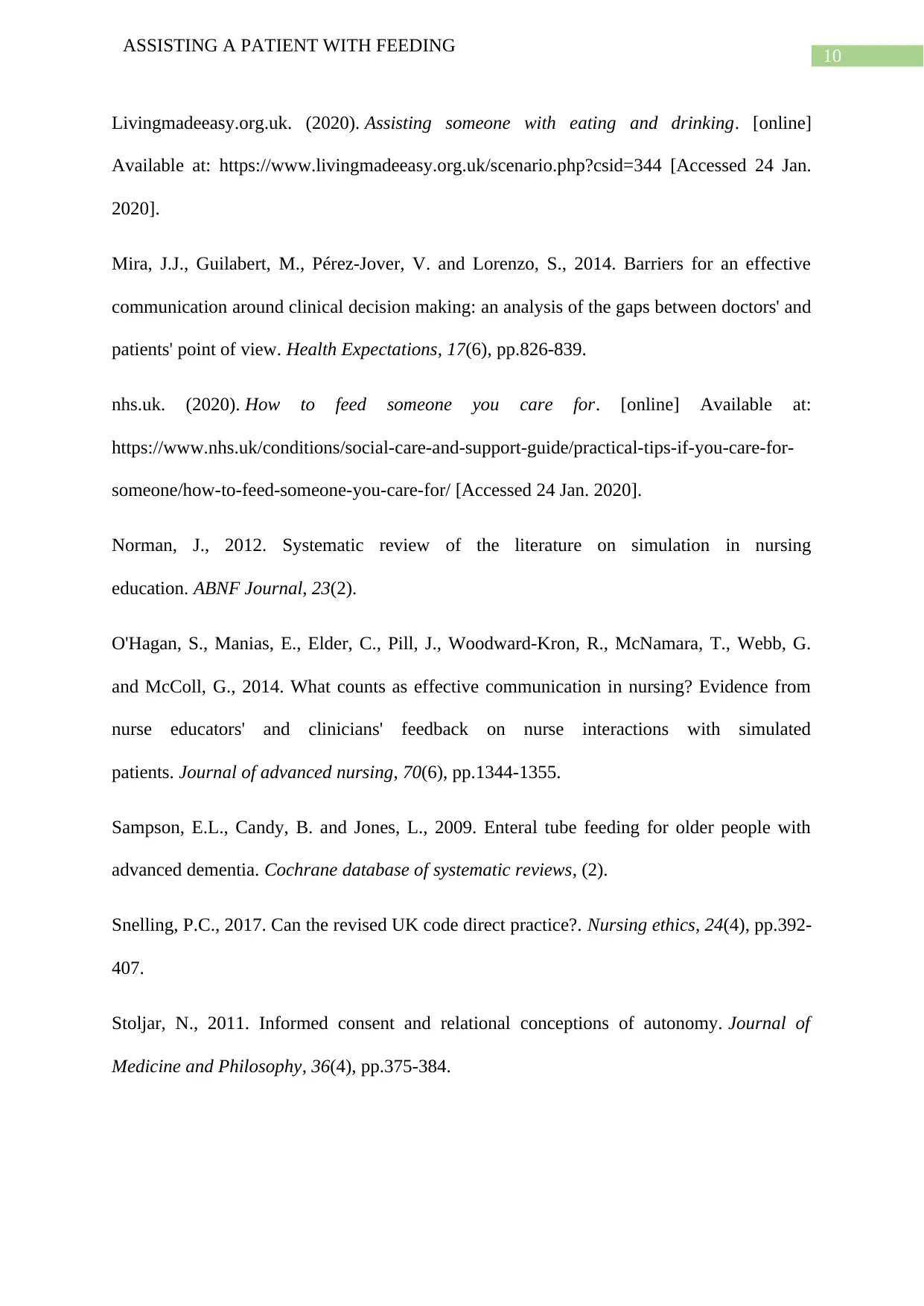
10
ASSISTING A PATIENT WITH FEEDING
Livingmadeeasy.org.uk. (2020). Assisting someone with eating and drinking. [online]
Available at: https://www.livingmadeeasy.org.uk/scenario.php?csid=344 [Accessed 24 Jan.
2020].
Mira, J.J., Guilabert, M., Pérez‐Jover, V. and Lorenzo, S., 2014. Barriers for an effective
communication around clinical decision making: an analysis of the gaps between doctors' and
patients' point of view. Health Expectations, 17(6), pp.826-839.
nhs.uk. (2020). How to feed someone you care for. [online] Available at:
https://www.nhs.uk/conditions/social-care-and-support-guide/practical-tips-if-you-care-for-
someone/how-to-feed-someone-you-care-for/ [Accessed 24 Jan. 2020].
Norman, J., 2012. Systematic review of the literature on simulation in nursing
education. ABNF Journal, 23(2).
O'Hagan, S., Manias, E., Elder, C., Pill, J., Woodward‐Kron, R., McNamara, T., Webb, G.
and McColl, G., 2014. What counts as effective communication in nursing? Evidence from
nurse educators' and clinicians' feedback on nurse interactions with simulated
patients. Journal of advanced nursing, 70(6), pp.1344-1355.
Sampson, E.L., Candy, B. and Jones, L., 2009. Enteral tube feeding for older people with
advanced dementia. Cochrane database of systematic reviews, (2).
Snelling, P.C., 2017. Can the revised UK code direct practice?. Nursing ethics, 24(4), pp.392-
407.
Stoljar, N., 2011. Informed consent and relational conceptions of autonomy. Journal of
Medicine and Philosophy, 36(4), pp.375-384.
ASSISTING A PATIENT WITH FEEDING
Livingmadeeasy.org.uk. (2020). Assisting someone with eating and drinking. [online]
Available at: https://www.livingmadeeasy.org.uk/scenario.php?csid=344 [Accessed 24 Jan.
2020].
Mira, J.J., Guilabert, M., Pérez‐Jover, V. and Lorenzo, S., 2014. Barriers for an effective
communication around clinical decision making: an analysis of the gaps between doctors' and
patients' point of view. Health Expectations, 17(6), pp.826-839.
nhs.uk. (2020). How to feed someone you care for. [online] Available at:
https://www.nhs.uk/conditions/social-care-and-support-guide/practical-tips-if-you-care-for-
someone/how-to-feed-someone-you-care-for/ [Accessed 24 Jan. 2020].
Norman, J., 2012. Systematic review of the literature on simulation in nursing
education. ABNF Journal, 23(2).
O'Hagan, S., Manias, E., Elder, C., Pill, J., Woodward‐Kron, R., McNamara, T., Webb, G.
and McColl, G., 2014. What counts as effective communication in nursing? Evidence from
nurse educators' and clinicians' feedback on nurse interactions with simulated
patients. Journal of advanced nursing, 70(6), pp.1344-1355.
Sampson, E.L., Candy, B. and Jones, L., 2009. Enteral tube feeding for older people with
advanced dementia. Cochrane database of systematic reviews, (2).
Snelling, P.C., 2017. Can the revised UK code direct practice?. Nursing ethics, 24(4), pp.392-
407.
Stoljar, N., 2011. Informed consent and relational conceptions of autonomy. Journal of
Medicine and Philosophy, 36(4), pp.375-384.
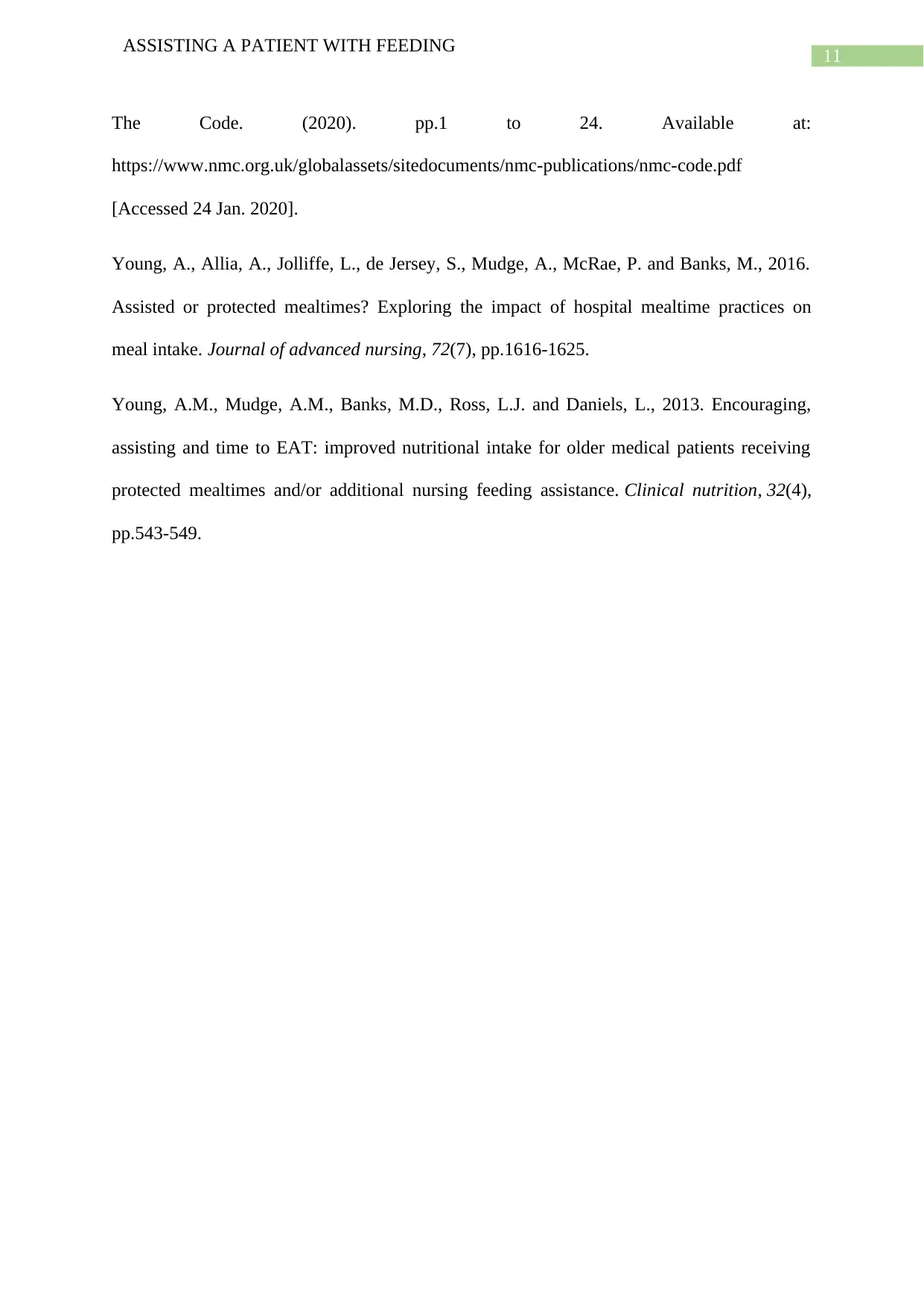
11
ASSISTING A PATIENT WITH FEEDING
The Code. (2020). pp.1 to 24. Available at:
https://www.nmc.org.uk/globalassets/sitedocuments/nmc-publications/nmc-code.pdf
[Accessed 24 Jan. 2020].
Young, A., Allia, A., Jolliffe, L., de Jersey, S., Mudge, A., McRae, P. and Banks, M., 2016.
Assisted or protected mealtimes? Exploring the impact of hospital mealtime practices on
meal intake. Journal of advanced nursing, 72(7), pp.1616-1625.
Young, A.M., Mudge, A.M., Banks, M.D., Ross, L.J. and Daniels, L., 2013. Encouraging,
assisting and time to EAT: improved nutritional intake for older medical patients receiving
protected mealtimes and/or additional nursing feeding assistance. Clinical nutrition, 32(4),
pp.543-549.
ASSISTING A PATIENT WITH FEEDING
The Code. (2020). pp.1 to 24. Available at:
https://www.nmc.org.uk/globalassets/sitedocuments/nmc-publications/nmc-code.pdf
[Accessed 24 Jan. 2020].
Young, A., Allia, A., Jolliffe, L., de Jersey, S., Mudge, A., McRae, P. and Banks, M., 2016.
Assisted or protected mealtimes? Exploring the impact of hospital mealtime practices on
meal intake. Journal of advanced nursing, 72(7), pp.1616-1625.
Young, A.M., Mudge, A.M., Banks, M.D., Ross, L.J. and Daniels, L., 2013. Encouraging,
assisting and time to EAT: improved nutritional intake for older medical patients receiving
protected mealtimes and/or additional nursing feeding assistance. Clinical nutrition, 32(4),
pp.543-549.
⊘ This is a preview!⊘
Do you want full access?
Subscribe today to unlock all pages.

Trusted by 1+ million students worldwide
1 out of 12
Related Documents
Your All-in-One AI-Powered Toolkit for Academic Success.
+13062052269
info@desklib.com
Available 24*7 on WhatsApp / Email
![[object Object]](/_next/static/media/star-bottom.7253800d.svg)
Unlock your academic potential
Copyright © 2020–2025 A2Z Services. All Rights Reserved. Developed and managed by ZUCOL.





